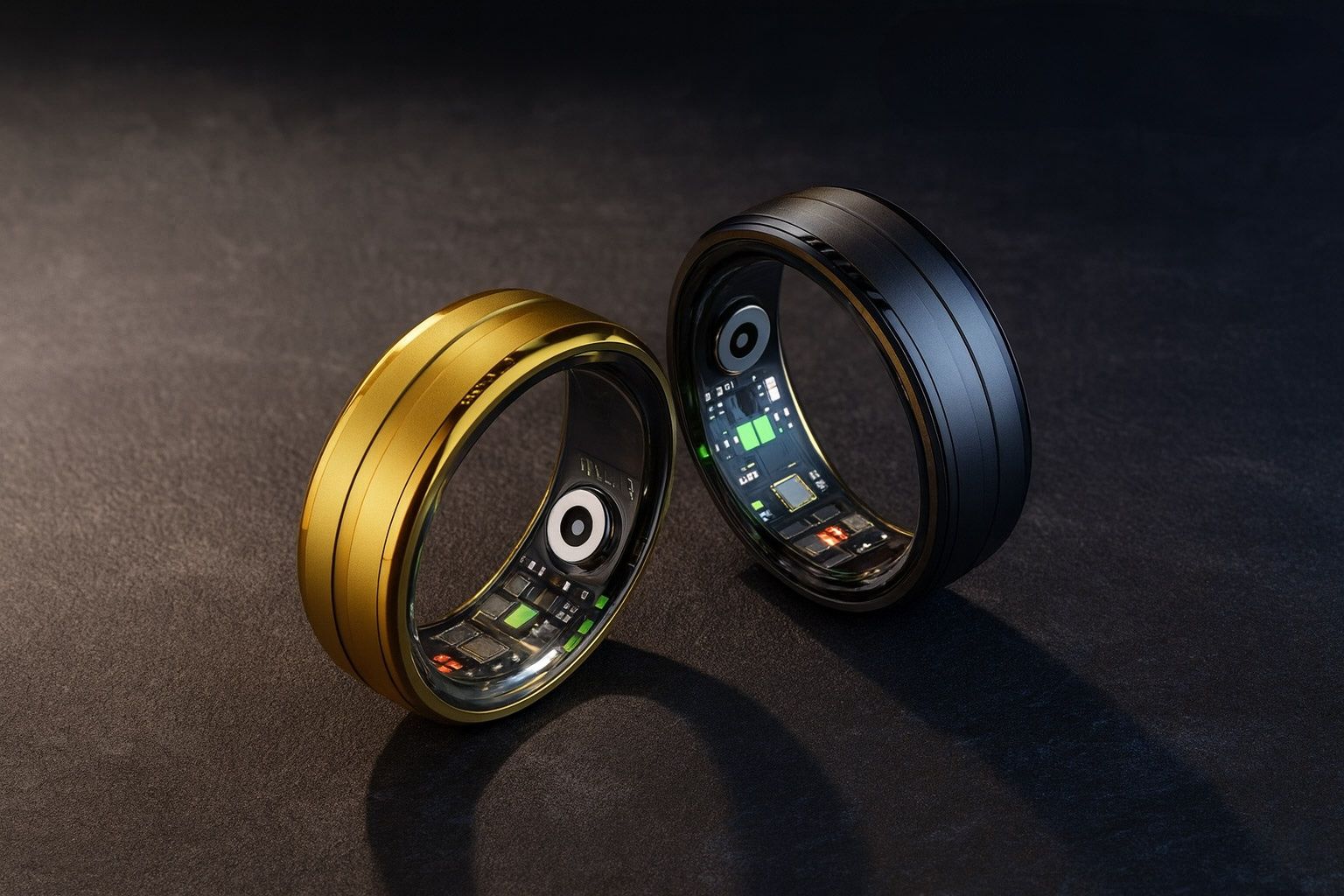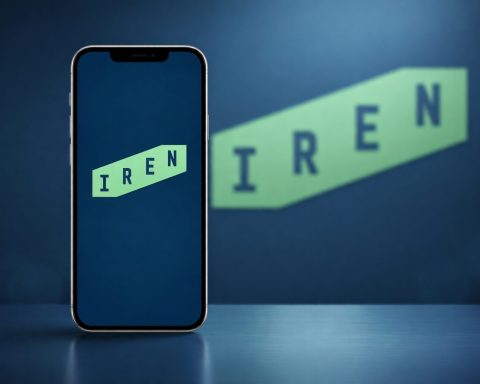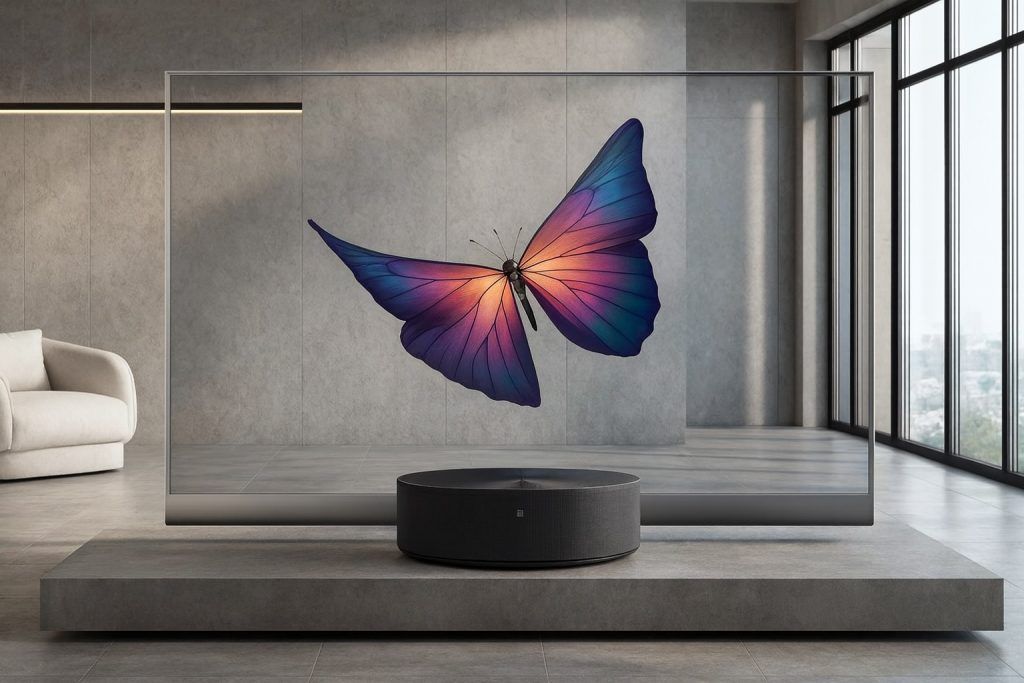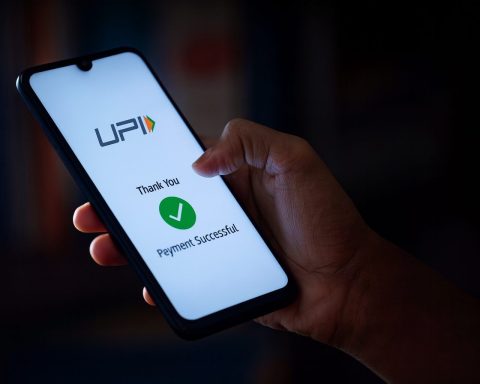- Oura Ring 4 (2023) costs $349 plus $5.99/mo, offers about 6–8 days of battery life, and includes PPG heart rate, SpO2, and skin temperature sensors with best-in-class sleep and recovery tracking.
- Samsung Galaxy Ring (2024) is priced at $399 with no subscription, lasts ~5–7 days per charge, includes PPG heart rate, skin temperature, and accelerometer, and provides AI-powered Energy Score and sleep coaching while lacking ECG, blood pressure, or body composition sensors and is Android-only.
- Ultrahuman Ring Air (2023) costs $349 with no subscription, offers ~4–6 days of battery, tracks heart rate, HRV, sleep, activity, skin temperature, SpO2, and has a 6-axis motion sensor with optional PowerPlugs add-ons for extra features.
- RingConn Gen 2 (2024) is $299 with no subscription, lasts about 10–12 days on a charge, is ~2 mm thick and 2–3 g, IP68 rated to 50 m, and tracks heart rate, SpO2, skin temperature, accelerometer, and gyroscope while offering AI-driven insights in the app.
- Noise Luna Ring 2 (2025) is around $300 with no subscription, claims up to 30 days of battery with the charging case, and monitors heart rate, SpO2, skin temperature, accelerometer, plus a built‑in AI voice assistant (launching globally in March 2025).
- Amazfit Helio (2024) costs $199 with no subscription, reaches about 6–7 days of battery life, and tracks heart rate, skin temperature, EDA stress, and accelerometer with 10ATM water resistance and a titanium build.
- Movano Evie (2024 re-launch) at $269, offers about 5 days of battery, and focuses on women’s health with sensors for heart rate, SpO2, skin temperature, accelerometer, and gyroscope, including sizes for smaller fingers and FDA accuracy pursuits.
- Circular Ring Slim (2024) priced at $275, provides ~2 days (up to 6 with Eco mode) of battery, includes PPG heart rate, skin temperature, bioimpedance, and accelerometer, and is noted as the thinnest ring (~2 g) with Ring 2 adding ECG and an 8-day battery in 2025.
- Prevention Circul+ (2023) costs $299 with ~16 hours of battery life, delivers ECG, blood pressure (PPG cuff-calibrated), SpO2, heart rate, and skin temperature, with FDA-approved SpO2 and shareable health reports for doctors but a bulky, short-battery design for casual use.
- Acer FreeSense (Late 2025) is listed at $199 with ~3–4 days of battery, features PPG heart rate, SpO2, skin temperature, and accelerometer, has no subscription, and targets iOS/Android users as a first-gen Acer ring.
Smart rings are booming and here to stay [1]. In fact, 2025 has seen a resurgence of high-tech rings from big brands and startups alike, all vying for a spot on your finger. These tiny wearables promise to track your health, help manage stress and sleep, and even let you pay with a wave of your hand. With so many newcomers (I mean, one reviewer wore six rings at once last summer just to test them! [2]), it’s getting incredibly challenging to choose between top options [3]. Fear not – this in-depth report will compare the latest and most popular smart rings of 2025 and peek at the upcoming innovations expected in 2026.
We’ll cover everything from health and fitness tracking, sleep and stress monitoring, to cool extras like contactless payments, app notifications, biometric security, smart home tricks, and battery life. You’ll also find quotes from tech experts and links to official product pages and reviews for deeper insight. Whether you’re eyeing a discreet wellness tracker to replace your smartwatch or just curious about the one ring that might rule them all, read on.
Smart Rings at a Glance (2025 Edition)
Below is a side-by-side comparison of 10 prominent smart rings – both those available now (2025) and a few announced for 2025/2026. This quick reference highlights key features, pricing, battery life, and compatibility for each device:
| Smart Ring (Release) | Price | Battery Life | Health Sensors & Features | Standout Features | Compatibility |
|---|---|---|---|---|---|
| Oura Ring 4 (2023) | $349 + $5.99/mo sub | ~6–8 days [4] | PPG heart rate, SpO2 (Blood O2), skin temperature, accelerometer | Best-in-class sleep & recovery tracking [5]; polished app; AI insights (meal logging, circadian rhythm) [6] | iOS, Android [7] |
| Samsung Galaxy Ring (2024) | $399 (no sub) | ~5–7 days [8] | PPG heart rate, skin temperature, accelerometer | AI-powered coaching (Energy Score, sleep animal chronotypes) [9] [10]; Galaxy Watch synergy extends battery [11]; camera control & gesture commands (Samsung phones) [12] [13] | Android (Samsung features require Samsung phone) [14] |
| Ultrahuman Ring Air (2023) | $349 (no sub) | ~4–6 days [15] | PPG heart rate, SpO2, skin temp, 6-axis motion sensor | Fitness-focused metrics; no subscription (uses optional PowerPlugs add-ons) [16]; circadian coaching (e.g. optimal caffeine timing) [17]; integrates with Ultrahuman’s glucose tracking (CGM) [18] | iOS, Android [19] |
| RingConn Gen 2 (2024) | $299 (no sub) | ~10–12 days [20] | PPG heart rate, SpO2, skin temp, accelerometer, gyroscope | Ultrathin (≈2 mm), ultralight (2–3g) design [21] – most comfortable to wear; Battery champion (up to 12 days) [22]; budget-friendly alternative to Oura [23] | iOS, Android |
| Noise Luna Ring 2 (2025) | ~$300 (no sub) | Up to 30 days | PPG heart rate, SpO2, skin temp, accelerometer | AI Voice Assistant built-in [24]; aggressive 30-day battery claim (with charging case) [25]; subscription-free lifetime AI coaching [26]; stylish finishes by India’s top wearables brand | iOS, Android (Launching globally Mar 2025) [27] |
| Amazfit Helio (2024) | $199 (no sub) | ~6–7 days (est.) | PPG heart rate, skin temp, EDA stress sensor, accelerometer | Sleek titanium build (scratch-proof) [28] [29]; 10ATM water resistant (swim-proof) [30]; syncs with Zepp app (for Amazfit smartwatch users) [31] | iOS, Android |
| Movano Evie (2024 re-launch) | $269 (no sub) | ~5 days (est.) | PPG heart rate, SpO2, skin temp, accelerometer, gyroscope | Women’s health focus (menstrual cycle & mood tracking) [32]; thin, elegant design (sizes for smaller fingers); seeking FDA clearance for accuracy [33] | iOS, Android (US launch) |
| Circular Ring Slim (2024) | $275 (no sub) | ~2 days (up to 6 in eco) [34] | PPG heart rate, skin temp, bioimpedance, accelerometer | Thinnest & lightest (~2g, 2.2 mm) ring [35]; Kira⁺ AI assistant for insights; new Ring 2 model (2025) adds ECG + 8-day battery [36] | iOS, Android |
| Prevention Circul+ (2023) | $299 (no sub) | ~16 hours [37] [38] | ECG (Electrocardiogram), Blood Pressure (PPG cuff-calibrated), SpO2, heart rate, skin temp | Medical-grade metrics (FDA-approved SpO2 tracking) [39]; measures blood pressure when calibrated [40]; shareable health reports for doctors [41]; not for casual use (bulky design, very short battery) [42] [43] | iOS, Android |
| Acer FreeSense (Late 2025) | $199 (no sub) | TBA (~3–4 days est.) | PPG heart rate, SpO2, skin temp, accelerometer | First-gen Acer ring – lightweight titanium design with AI insights [44] [45]; no subscription fee for full features [46]; competitive price from a major tech brand | iOS, Android (Coming 2025) |
Upcoming or recently announced device (shipping by late 2025 or 2026). Battery claim for Luna Ring 2 includes use of its charging carry-case [47].
* Acer FreeSense is expected in late 2025; final specs TBA (hands-on demo unit tested) [48].
As you can see, smart rings come in a range of styles and specialties. Next, let’s dive deeper into each ring’s features, pros and cons, pricing, and what makes them stand out.
Oura Ring 4 – The Wellness Powerhouse
The Oura Ring 4 is widely regarded as the best smart ring for most people – and for good reason. Oura essentially pioneered this category, and many rivals “follow the example Oura set this past decade” [49] [50]. Priced around $349 (with a $5.99/month membership for advanced insights), the Oura Ring 4 isn’t cheap, but it delivers a comprehensive health tracking experience. It’s a unisex, minimalist titanium ring available in multiple finishes (silver, black, gold, etc.), and comes in sizes 4–15, one of the widest ranges on the market [51].
Health & Fitness: Oura packs an array of sensors (optical heart-rate PPG, infrared sensors, temperature sensors, accelerometer) to monitor your heart rate, heart rate variability (HRV), respiratory rate, blood oxygen (SpO₂), body temperature, and more. It’s best known for exceptional sleep tracking accuracy, aided by strong validation in clinical trials [52]. Each morning, the Oura app provides three key scores – Sleep, Readiness, and Activity – distilled from your overnight data and daily activity. Users get detailed sleep stage breakdowns, recovery insights, and even guidance on aligning with your circadian rhythm [53].
Stress & Recovery: Oura has expanded beyond basic tracking to focus on stress management and long-term health trends. The app now analyzes your stress resistance, cardiovascular fitness (VO₂max proxy), “cardio age,” and other metrics over time [54]. If you log your meals, Oura’s new AI-powered features can assess meal timing regularity, and its “moment” features help with mindfulness and relaxation. In fact, Oura recently even launched an AI chatbot coach to interpret your data (though some find its advice a bit obvious) [55].
Other Features: Unlike some smartwatches, the Oura Ring doesn’t do notifications or contactless payments – it’s laser-focused on health. It lacks NFC, so you can’t pay with it, and there’s no display or vibrator for alerts. However, it syncs with Apple Health and Google Fit, and the rich data it provides can complement other devices. Battery life is solid at about 6–7 days per charge in real use (up to ~8 days max) [56]. One downside: Oura still uses a charging dock (no portable charging case), so you’ll need to top it up on a dock ~once a week.
Expert Insights: Reviewers consistently praise Oura’s accuracy and polished app. Wareable calls the Oura Ring 4 “the best wellness tracker out there,” noting its “brilliant presentation of data” [57]. “The Oura app is the most polished we’ve used,” raves Wareable [58], and sleep tracking accuracy is exceptional. The Verge’s wearable tech expert Victoria Song agrees Oura is still the one to beat for reliability, accuracy, and experience [59]. She notes Oura continues to invest in research and frequently updates its features [60], keeping it ahead of the pack.
Pros:
- Top-notch sleep and recovery tracking with highly accurate data [61].
- Polished app with clear insights and trends (e.g. circadian rhythm alignment) [62].
- Continuous improvements – regular feature updates (AI meal logging, etc.) [63] and strong research backing.
- Global compatibility – works with iOS/Android; ships worldwide [64].
Cons:
- Very expensive – one of the priciest rings plus a subscription fee [65] [66].
- Bulky profile – a bit thicker than some rivals; not the slimmest ring look [67].
- Limited beyond health – no smartwatch-like functions (no payments, notifications, etc.).
- Workout tracking is iffy – not as great for tracking exercise heart rate or GPS (no built-in workout mode aside from basic activity count) [68].
Bottom Line: If you want deep health insights in a discreet form, and are willing to invest, Oura Ring 4 remains the gold standard of smart rings in 2025. It’s especially ideal for sleep quality nerds and those who love poring over wellness metrics. Just be prepared to pay a premium for its polished experience and to wear a ring that, while comfortable, isn’t the thinnest on the market.
Samsung Galaxy Ring – The New Contender with AI Smarts
Samsung made a bold entry into the smart ring arena with the Galaxy Ring in late 2024, and it quickly became one of 2025’s top smart rings. As a first-generation product, the Galaxy Ring impresses with its sleek hardware and tight integration into the Samsung ecosystem. It comes in three finishes (silver, black, gold) and is built from titanium for durability [69]. Priced at $399 (no subscription required), it’s on par with high-end rings like Oura. However, note that it’s compatible only with Android, and certain features are exclusive to Samsung phone users [70].
Health & Fitness: The Galaxy Ring’s sensor suite includes an optical heart rate (PPG) sensor, a skin temperature sensor, and an accelerometer [71]. It focuses on the core metrics: sleep, activity, and heart health. In fact, sleep tracking is a huge focus. Samsung gives you a fun “sleep animal” chronotype and actionable sleep coaching tips based on your patterns [72]. Reviewers found the sleep accuracy very solid – “the Galaxy Ring gets sleep accuracy and activity tracking bang on,” says Wareable [73]. The ring also computes a daily “Energy Score” (similar to a readiness score) derived from your sleep, HRV, and heart rate; Samsung’s AI then offers insights if your score is unusually high or low [74].
For fitness tracking, the Galaxy Ring can measure exercise heart rate and auto-detect some workouts. In fact, Wareable noted exercise heart-rate was more accurate than any smart ring tested (a notable feat) [75]. That said, it lacks some advanced health sensors that Samsung’s watches have – there’s no ECG, no blood pressure, no body composition (BIA) in the ring [76]. It covers the basics well but doesn’t venture into medical-grade territory.
AI and Smart Features: Samsung leverages its broader ecosystem to add unique smart features. The Galaxy Ring has a handy charging case (something Oura lacks) which doubles as a secure carrying case [77]. When paired with a Galaxy smartphone and Galaxy Watch, the ring can “trade tasks” with the watch to extend each other’s battery life (for example, the ring can count steps while your watch charges) [78]. This ecosystem synergy means a Galaxy Watch wearer could get nearly 10 days combined use without charging by alternating devices [79]. Additionally, Samsung enabled nifty gesture controls: for example, with a Galaxy Z Flip6 or Fold6 phone, you can double-pinch your fingers to remotely snap a photo or dismiss alarms with a pinch using the ring’s motion sensor [80] [81]. These are small conveniences that feel almost magical – “an almost Apple-like seamlessness” in Samsung’s ecosystem when you have the phone, watch, and ring working together [82].
Samsung also touts its “Galaxy AI” integration – essentially, on Samsung phones, you get extra AI-driven insights like daily wellness tips (“Booster Cards”) and more detailed Energy Score analysis [83]. However, this is a double-edged sword: those features only show up if you’re using a Samsung phone, making the ring less appealing to, say, a Google Pixel or OnePlus owner (it will still work on other Androids but without the exclusive AI extras) [84]. There’s currently no iOS support at all, so iPhone users need not apply.
Battery & Build: Battery life is roughly 5–7 days per charge in typical use, which is decent (not as long as RingConn or Oura, but enough for nearly a week). The included USB-C charging case makes it easy to top up the ring on the go – a full charge takes around 80 minutes [85]. The ring is rated 5ATM/IP68 water resistant (good for swimming and 100m depth) [86] [87], and its concave inner design is comfortable for all-day wear. At just 2.3–3 grams, it’s lighter than Oura [88].
Expert Insights: Tech reviewers have lauded the Galaxy Ring as “a fantastic first-generation effort” [89]. “The hardware is excellent – slim, lightweight, and elegant,” writes The Verge, which also loved the charging case and comfort [90]. The no-subscription model is a welcome change; as one reviewer quipped, paying $400 is easier to swallow knowing you won’t be hit with monthly fees [91]. However, experts also caution that it’s not yet the category leader: “Samsung is still catching up with sleep tracking accuracy, and its AI health features are hit or miss,” notes The Verge [92]. Wareable similarly felt that while Galaxy Ring covers the core experience well, it doesn’t offer as many insights as Oura or Ultrahuman for deeper wellness trends [93]. Also, if you already have a Galaxy Watch, the ring doesn’t add new health metrics – it actually does less than a watch (no display, fewer sensors) [94].
Pros:
- Accurate sleep and activity tracking, with helpful sleep coaching features [95].
- No subscription fees – full functionality out of the box [96].
- Innovative smart features if you’re in the Samsung ecosystem (gesture controls, camera remote, seamless phone/watch integration) [97] [98].
- Premium build – lightweight titanium ring with a comfy design and a handy charging case [99].
Cons:
- Android-only – no iPhone support at all, and some features require a Samsung phone [100].
- Expensive upfront (comparable to Oura) – and while it’s fee-free, the full “Galaxy experience” assumes you also own a pricey Galaxy phone and watch [101].
- First-gen quirks – a few accuracy gaps (e.g. SpO₂ readings were sometimes off in tests) [102]; not as many long-term insights as Oura offers [103].
- No advanced health sensors – lacks ECG or blood pressure features that some competitors or smartwatches have [104].
Bottom Line: The Samsung Galaxy Ring is the top choice for Android users who want a smart ring. It’s especially attractive if you’re a Samsung devotee – in that case, it becomes a sleek extension of your Galaxy phone and watch. It nails the fundamentals (sleep, fitness) and sprinkles in some futuristic AI-driven perks. However, non-Samsung users might find it offers a bit less value, and those seeking the deepest wellness insights may still lean toward Oura or others. As a first-gen device, it’s remarkably well-rounded – and it sets the stage for even more from Samsung if a Galaxy Ring 2 arrives in 2026.
Ultrahuman Ring Air – Fitness Coach on Your Finger (No Subscription)
The Ultrahuman Ring Air is an ambitious smart ring from metabolic health startup Ultrahuman. Launched in 2023 as a second-gen product, the Ring Air quickly became known as a top alternative to Oura, especially for those who hate subscriptions. Priced at $349 (with no monthly fees), it offers a comprehensive set of health features and a distinctly fitness-oriented approach.
Design & Hardware: The Ultrahuman Ring Air is slim and lightweight – just 2.4 to 3.6 grams depending on size [105] – making it one of the lighter rings (roughly on par with Samsung’s ring). It’s made of titanium with a durable coating, and while not the absolute thinnest, it’s comfortable for 24/7 wear. Battery life is about 4–6 days on a charge [106], a bit shorter than Oura, but it charges in ~2 hours. It’s water resistant (IPX8) for up to 100m, so swimming and showers are fine [107].
Health & Fitness Features: Ultrahuman’s ring tracks all the usual suspects: heart rate, HRV, sleep, activity, temperature, and blood oxygen. It even has colored LEDs and an infrared sensor for more precise readings [108]. Where Ultrahuman differentiates itself is in the type of insights it provides. The companion app leans more toward fitness and metabolic health than general wellness. For example, it has a strong focus on workout readiness and recovery. It gives a daily recovery score based on resting heart rate, HRV, and temperature deviations (with a simple green/yellow/red indicator to show if you’re outside your norms) [109].
Another unique aspect is Ultrahuman’s emphasis on circadian rhythm and stimulants management. The ring/app will analyze your daily energy patterns and even suggest an “Adenosine Clearance Window” – basically advising when it’s best to have your coffee for optimal effect and when to cut off caffeine [110]. It also gives prompts for things like getting morning sunlight and taking movement breaks to keep your circadian clock on track [111] [112]. This level of biohacking insight is something Oura doesn’t explicitly do.
Ultrahuman has also carved a niche by integrating with its other health products. If you use the Ultrahuman continuous glucose monitor (CGM) patch (they sell an M1 sensor subscription separately), the Ring’s app can combine your glucose data with your recovery metrics to give a more complete picture [113]. For instance, you might see how a poor night’s sleep (detected by the ring) correlates with glucose variability the next day – a boon for those deeply into metabolic fitness.
No Subscription, but “PowerPlugs”: Instead of a monthly subscription, Ultrahuman uses a unique model of optional add-on features called “PowerPlugs.” Think of these like plugins to extend functionality. Some are free – e.g., a smart alarm that wakes you during light sleep, or menstrual cycle tracking for women [114]. Others are paid one-time or small recurring fees – for example, Ultrahuman is planning an AFib (atrial fibrillation) detection PowerPlug (likely leveraging the ring’s HRV data) and a “cardio adaptability” metric; one of these currently costs about $2.90/month [115]. The idea is you only pay for advanced features you actually want. It’s a refreshing twist that can still save users money compared to Oura’s blanket subscription.
App and Accuracy: While Ultrahuman’s data is solid, some reviewers note the app isn’t as polished or user-friendly as Oura’s yet [116] [117]. It presents lots of raw metrics which can feel a bit overwhelming or “raw” to interpret [118]. Sleep tracking is generally good, though perhaps slightly generous in totals (meaning it might overestimate sleep by a bit) [119]. The biggest weakness noted was workout heart rate tracking – early reviews found that during intense exercise, the Ring Air’s HR readings could be “wildly inaccurate” at times [120], though firmware updates (including an automatic workout detection mode) have improved basic activity tracking now [121]. Still, if you’re running or doing HIIT, a chest strap or watch might be more reliable for heart rate than a ring.
On the plus side, Ultrahuman continues to update and improve the platform. They’ve added features like a jet lag advisor and integration with blood testing services for a holistic health view [122]. The app also provides motivational nudges – e.g., “thoughtful prompts and recommendations” to build healthier habits [123], like reminders to delay coffee or wind down at night.
Pros:
- No subscription needed – one-time cost gets full functionality [124].
- Solid health tracking accuracy (sleep, HRV, etc.) and interesting insights on stimulants timing, circadian rhythm, etc. [125] [126].
- Expandable features via PowerPlugs – customize (and pay for) only the extras you want [127].
- Integrates with metabolic health tools (Ultrahuman CGM, etc.) – great for fitness enthusiasts and biohackers.
- Lightweight comfort – slim design, multiple color options (black, grey, gold, silver) [128].
Cons:
- App is not as polished – can be dense with data and less intuitive than Oura’s [129] [130].
- Design still a bit chunky – some find it a tad thick or with a “masculine” look [131] (Ultrahuman hasn’t quite matched the thinness of the slimmest rings yet).
- Missing some metrics – e.g., no respiratory rate or blood oxygen trends explicitly shown (and no breathing exercise feature) [132].
- Exercise HR tracking can falter – not the best choice if you want accurate heart rate during intense workouts [133].
- Limited ecosystem integration – while it syncs with Apple Health, it doesn’t have the kind of smart home/phone features Samsung’s ring does (no gestures or notifications).
Bottom Line: The Ultrahuman Ring Air is a compelling choice for those who want powerful health insights without a recurring fee. It’s like having a fitness coach in a ring – especially useful if you care about optimizing your energy levels, metabolic health, and workout recovery. The product is still evolving, but Ultrahuman’s innovative ideas (caffeine guidance, plug-in features, etc.) show how smart rings can be more than just mini-watches. If you’re an Oura skeptic due to the subscription, the Ring Air is one of the best subscription-free alternatives [134] that still competes well on data – just be ready to geek out a bit with the app to get the most from it.
RingConn Gen 2 – Battery Champ on a Budget
If battery life is your top priority (or you’re on a tighter budget), RingConn is a name to know. The RingConn Gen 2 smart ring, released in 2024, has quickly gained a reputation as “the undisputed battery champion” among smart rings [135]. It can last 10–12 days on a single charge [136], obliterating the 4–7 day norm that Oura and others get. At around $299 (no subscription required), RingConn offers tremendous value with only a few compromises.
Design & Comfort: The Gen 2 ring is incredibly thin and light. At roughly 2 mm thick and weighing just 2–3 grams (depending on ring size), it’s about the closest a smart ring gets to feeling like a normal band [137]. Wareable’s team even said this “makes it arguably the best smart ring to own from a comfort perspective”, noting it’s “as close to a regular ring as we’ve ever experienced” when wearing daily and sleeping with it [138]. The ring comes in finishes like silver, matte black, and gold. Durability is decent, though the matte black coating can show a bit of wear on the edges over time [139] – a common issue with black rings.
Despite its slim form, RingConn didn’t skimp on water resistance – it’s rated IP68 (50m), so you can shower or swim with it. It also includes a small charging dock; with such infrequent charges needed, many users joke you’ll forget where you left the charger!
Health Tracking: RingConn Gen 2 tracks heart rate, sleep, SpO₂, skin temperature, and activity using similar sensors to Oura (PPG, accelerometer, etc.) [140]. It may not have exotic sensors like ECG, but it nails the fundamentals. Users get daily scores for sleep, readiness, and activity, much like Oura’s system. During tests, its sleep and health data proved quite accurate and on par with more expensive rings [141]. One standout is that because battery life is so long, you’re far less likely to miss nights of data – you can easily wear it continuously for 10 days, whereas an Oura might require you to skip a night for charging every 5–6 days.
The RingConn app isn’t as well-known as the big players, but it’s functional. Interestingly, the latest RingConn app version heavily incorporates AI-driven insights, albeit with “middling effect” according to The Verge [142]. It attempts to give personalized tips or explain patterns using AI, though this can sometimes feel generic. Still, having any guided interpretation at this price point is a plus.
Gen 2 Air Variant: In 2025, RingConn launched the Gen 2 Air, a slightly pared-down version of the ring for $199. It retains the key features but in an even slimmer form factor with fewer color options. Early hands-on impressions are that the Gen 2 Air “looks and feels a lot nicer than the original” and is more comfortable thanks to a refined shape [143]. It still achieved about 8–9 days of battery in tests – “far better than any other smart ring I’ve tested,” noted one reviewer [144]. If you’re okay with a more entry-level approach (perhaps slightly less robust build or sensors), the Gen 2 Air makes RingConn’s battery and comfort advantages even more affordable.
Limitations: Being a smaller brand, RingConn doesn’t yet have the deep polish of Oura or Samsung. For instance, the companion app has been described as a bit “mind-numbingly dense” in terms of data presentation [145]. It shows lots of charts but perhaps isn’t the slickest UI, and it lacks some of the refined wellness insights others provide. There are also fewer integrations – you can sync basic data to Google Fit or Apple Health, but RingConn isn’t part of broader wellness platforms beyond that.
Also, no advanced features like contactless payments or voice assistants here – RingConn is firmly focused on health tracking. And while the price undercuts Oura, it’s still a few hundred dollars, which might feel high for a brand you haven’t heard of. The good news is the community feedback from early backers and users has been largely positive, indicating RingConn delivered on its promises by Gen 2.
Pros:
- Unrivaled battery life – around 10 days per charge is best-in-class [146] (no more constant charging anxiety!).
- Ultra-thin, lightweight comfort – one of the slimmest designs, very easy to wear 24/7 [147].
- Affordable alternative – solid suite of health features for significantly less money (and no subscription) [148].
- Accurate core tracking – sleep, heart rate, etc., perform on par with pricier rings in tests.
- Gen 2 Air offers even cheaper option – $199 for ~8+ days battery and similar capabilities, broadening access [149].
Cons:
- App/user experience – not as refined; data can be overwhelming or less actionable (lots of graphs, fewer guided insights) [150].
- Brand maturity – as a newer brand, long-term support and frequent updates aren’t guaranteed (though so far, they’ve been responsive).
- Durability of finish – especially the black color may scratch or scuff at the edges with heavy use [151] (consider silver or gold if you want fewer marks).
- No “smart” extras – no notification alerts, no payment capabilities, no integrations with smart home – purely a health ring.
Bottom Line:RingConn Gen 2 proves you don’t need to spend $400+ or charge every few days to get quality health tracking. It’s the ideal smart ring for those prioritizing comfort and battery life, or anyone wanting to dip their toes into ring-wearables without breaking the bank. While it lacks the brand prestige and advanced analytics of Oura, it covers the basics surprisingly well. With the Gen 2 and Gen 2 Air, RingConn has effectively carved out a niche as the longest-lasting smart ring that’s actually usable – a huge win for forgetful chargers and frequent travelers.
Other Notable Smart Rings (2025/2026) and Future Trends
Beyond the major players above, there are a few specialized smart rings and upcoming innovations worth mentioning – especially since they highlight features like contactless payments, biometric ID, and smart home integration that mainstream health rings typically lack:
- McLEAR / NFC Payment Rings: One of the earliest “smart ring” concepts was using a ring as a contactless payment token. Products like the McLEAR RingPay in the UK allowed users to link a credit/debit card and tap their ring on NFC payment terminals – no battery required. Users appreciated the convenience of always having your payment on your finger [152]. These rings are usually ceramic or resin and contain an NFC chip. CNICK is another brand that makes stylish rings (including wooden ones) that can unlock Tesla cars and make Visa payments via an NFC chip [153] [154]. While these aren’t health trackers at all, they show the potential for smart rings to replace wallets and keys. The downside is they offer no other features (no sensors), and in McLEAR’s case, the service was discontinued after a while [155] – indicating the challenge of building a payment ecosystem. Still, as payment-enabled wearables (like Apple Pay on Apple Watch) grow, rings could see a comeback in this area, perhaps integrated by big players in the future.
- Token Ring – Biometric Authentication: For those interested in security and biometric ID, the Token Ring is a fascinating device. Aimed at enterprise and personal security, it has an integrated fingerprint scanner on the inside of the ring. When you put it on and scan your finger, the ring activates and can then act as a secure token for logging into computers, opening smart locks, or even badging into the office. It supports multi-factor authentication standards (FIDO2, etc.) and includes an encrypted secure element chip [156]. Essentially, it’s a high-tech key that’s phishing-proof – if someone else wears it, it won’t work without your fingerprint [157]. Token Ring is more of a corporate device (it’s being used to replace security key fobs and cards), but it demonstrates how biometric authentication can be wrapped into a ring form factor. Don’t be surprised if in the coming years, your work ID or house keys become a smart ring that only you can use.
- Smart Rings for Notifications & Voice: A few attempts have been made to create rings that act as mini-communication devices. For example, Amazon experimented with the Echo Loop, a ring that had a tiny microphone and speaker to access Alexa voice assistant. You could literally talk into your hand and hear Alexa’s response in your finger. It could also vibrate for notifications and let you quickly take calls or send texts via voice. While Echo Loop was an invite-only trial and never mass-released, it showed that a ring can handle notifications/voice if designed for it. Another device, the ORII smart ring, uses bone conduction audio – you press your fingertip to your tragus (just outside your ear) and you can hear phone call audio through vibrations in your finger bones. It effectively turns your hand into a Bluetooth earpiece. ORII also supports basic voice commands (Siri/Google Assistant). These kinds of rings target a different use-case – more as phone remote controls or discreet communication gadgets. They haven’t hit mainstream success (likely due to limited battery and niche appeal), but as components get more power-efficient, we may see future rings incorporate limited notifications or an AI voice assistant. In fact, the upcoming Noise Luna Ring 2 is teasing a voice-activated AI assistant built-in [158] – potentially allowing you to ask health questions or control smart home devices through the ring. That could blur the line between a fitness ring and a mini smart assistant.
- Amazfit & Acer – Big Tech Joins In: The smart ring arena is attracting established tech companies now. Amazfit (Zepp Health) launched the Helio ring in 2024, and while the first-gen had mixed reviews (some called it a “bargain bin bust” due to software issues) [159], it signals that mainstream wearable makers see rings as the next frontier. Helio’s standout was a sleek titanium design and 10ATM water resistance – showing design innovation (and indeed, it was praised for being scratch-free after weeks of use [160]). Acer, known for PCs, surprised everyone by unveiling the Acer FreeSense smart ring in 2025. It’s targeting a $199 price with full health tracking, AI-driven personalized insights, and notably, no subscription fee [161]. Early impressions say “the AI-powered wearable delivers personalized insights in a lightweight design – all without a subscription” [162]. As more big players (perhaps Xiaomi, Huawei, etc.) enter the fray, we can expect prices to become more competitive and features like AI coaching to become standard.
- Apple Ring Rumors: We can’t discuss future trends without touching on Apple. For years there have been rumors and patents suggesting Apple is exploring a smart ring – perhaps as a companion to the Apple Watch or for AR/VR control. In 2024, an analyst report speculated that Apple could release a smart ring in 2026, potentially to complement its Vision Pro AR headset and continue Apple’s legacy in health wearables [163]. However, credible sources like Bloomberg’s Mark Gurman have poured cold water on these rumors, saying Apple has no active plans for a ring (and may have shelved the idea) [164]. It’s worth noting Apple has patented designs for rings with things like an edge-lit display for notifications [165] and using a ring to control other devices (like swiping in-air to control an Apple Glasses UI). If an “Apple Ring” ever does materialize, expect tight integration with HomeKit (imagine unlocking your door or starting your car with a flick of your ring) and Health app syncing. For now, though, it’s all speculation – “if an Apple Ring is coming, it is likely 2026 or later, if at all” [166]. Apple may be waiting to see if this market truly takes off or if it’s a niche.
- Materials and Design Trends: Many 2025 rings use titanium for its light weight and strength (Oura, Samsung, Ultrahuman, Acer all do). We’re also seeing more scratch-resistant coatings (DLC – diamond-like carbon, tungsten carbide coatings, etc.) to help rings survive daily wear and tear [167]. Water resistance has improved to the point that top rings are essentially swim-proof (5ATM/10ATM). A big design trend is clearly slimmer profiles – every new model tries to shave millimeters. The Velia ring, a startup shown at CES 2025, claimed to be “insanely slim” (almost like a thin wedding band) [168], though it’s facing crowdfunding delays. By 2026, we might finally have a ring that looks indistinguishable from a normal ring at a glance. Battery technology is also a focus – Noise’s Luna Ring 2 using a charging case to boost total life to 30 days is one clever approach [169]. Others might use flexible batteries or more efficient chips to extend runtime.
- AI & Biometrics: Expect even more AI-driven features in upcoming rings. Oura and Samsung already use AI for insights, Ultrahuman is experimenting with AI coaches, and Noise Luna is adding AI voice. As sensor data piles up, AI can help distill it into meaningful advice (“Hey, your stress levels have been high on Mondays – maybe schedule a lighter workload if possible.”). Biometric sensing might also expand – blood pressure via ring is already real in the Circul+ (albeit with calibration) [170], and Movano has hinted at working on glucose monitoring technology in the long run. Rings have even been proposed for detecting things like COVID onset via temperature and HR changes. The challenge is packing more sensors without sacrificing size or battery – a tricky balance that ongoing tech advancements will address.
Final Thoughts
Smart rings in 2025 have truly come of age – from hardcore health trackers to payment wearables to security tokens, these tiny bands are doing what would have seemed impossible a decade ago. The landscape is only getting more exciting for 2026. As one expert noted, “Smart rings are in the middle of a resurgence”, with many experimental ideas but also a few standout winners [171].
For consumers, the best smart ring depends on your needs:
- If you want holistic wellness and top-notch sleep tracking, the Oura Ring 4 still reigns supreme (just mind the cost).
- If you’re an Android user who loves cutting-edge integration, Samsung’s Galaxy Ring brings big-brand polish and fun AI features – no subscription needed.
- Hate subscriptions and love fitness? Ultrahuman Ring Air and RingConn 2 offer great alternatives, each with their own perks (metabolic insights vs. monster battery).
- Women looking for a tailored health device might keep an eye on Movano Evie as it matures – personalization in design and female health focus is its promise.
- Meanwhile, med-tech enthusiasts can even opt for a ring like Circul+ to monitor serious vitals like ECG and blood pressure – showing that rings aren’t just tech toys but can be legitimate health tools [172] [173].
As we approach 2026, we anticipate smarter, smaller, and more versatile rings. The day when you leave your house with just a ring – and it tracks your fitness, pays for your coffee, unlocks your car, and guards your online accounts – might not be far off. In the meantime, the 2025 generation of smart rings already offer an impressive array of capabilities in a tiny, stylish package. In the world of wearables, these rings are proving that sometimes the best things do come in small packages.
Sources: The information in this report is backed by insights from wearable tech reviews and experts, including Wareable [174] [175], The Verge [176] [177], Wired [178] [179], Tom’s Guide [180] [181], and official product pages (Samsung [182], AppleInsider [183], etc.), among others. Each specific claim is cited with a reference in the text for further reading. Enjoy exploring the next generation of smart rings and finding the one that suits you best! [184] [185]
References
1. www.wareable.com, 2. www.theverge.com, 3. www.wareable.com, 4. www.wired.com, 5. www.wareable.com, 6. www.theverge.com, 7. www.wired.com, 8. www.wired.com, 9. www.wareable.com, 10. www.wareable.com, 11. www.wired.com, 12. www.theverge.com, 13. www.wired.com, 14. www.wired.com, 15. www.wired.com, 16. www.theverge.com, 17. www.wareable.com, 18. www.wareable.com, 19. www.wired.com, 20. www.wareable.com, 21. www.wareable.com, 22. www.wareable.com, 23. www.wareable.com, 24. www.tomsguide.com, 25. www.tomsguide.com, 26. www.lunazone.com, 27. www.tomsguide.com, 28. www.wareable.com, 29. www.wareable.com, 30. www.wareable.com, 31. www.wareable.com, 32. www.wareable.com, 33. www.wareable.com, 34. www.counterpointresearch.com, 35. www.wareable.com, 36. www.androidcentral.com, 37. www.wareable.com, 38. www.wareable.com, 39. www.wareable.com, 40. www.wareable.com, 41. www.wareable.com, 42. www.wareable.com, 43. www.wareable.com, 44. www.tomsguide.com, 45. www.tomsguide.com, 46. www.tomsguide.com, 47. www.tomsguide.com, 48. www.tomsguide.com, 49. www.theverge.com, 50. www.theverge.com, 51. www.theverge.com, 52. www.wareable.com, 53. www.wareable.com, 54. www.wareable.com, 55. www.theverge.com, 56. www.wired.com, 57. www.wareable.com, 58. www.wareable.com, 59. www.theverge.com, 60. www.theverge.com, 61. www.wareable.com, 62. www.wareable.com, 63. www.theverge.com, 64. www.wareable.com, 65. www.wareable.com, 66. www.wareable.com, 67. www.wareable.com, 68. www.wareable.com, 69. www.samsung.com, 70. www.wired.com, 71. www.samsung.com, 72. www.wareable.com, 73. www.wareable.com, 74. www.wareable.com, 75. www.wareable.com, 76. www.wareable.com, 77. www.theverge.com, 78. www.wired.com, 79. www.androidpolice.com, 80. www.theverge.com, 81. www.wired.com, 82. www.wired.com, 83. www.wired.com, 84. www.wired.com, 85. www.wired.com, 86. www.wareable.com, 87. www.wareable.com, 88. www.wareable.com, 89. www.wareable.com, 90. www.theverge.com, 91. www.theverge.com, 92. www.theverge.com, 93. www.wareable.com, 94. www.wareable.com, 95. www.wareable.com, 96. www.theverge.com, 97. www.theverge.com, 98. www.wired.com, 99. www.theverge.com, 100. www.wired.com, 101. www.theverge.com, 102. www.wareable.com, 103. www.wareable.com, 104. www.wareable.com, 105. www.wareable.com, 106. www.wired.com, 107. www.wired.com, 108. www.wired.com, 109. www.wareable.com, 110. www.wareable.com, 111. www.wareable.com, 112. www.wareable.com, 113. www.wareable.com, 114. www.theverge.com, 115. www.theverge.com, 116. www.wareable.com, 117. www.wareable.com, 118. www.wareable.com, 119. www.wired.com, 120. www.wired.com, 121. www.wired.com, 122. www.wareable.com, 123. www.wareable.com, 124. www.wired.com, 125. www.wareable.com, 126. www.wareable.com, 127. www.theverge.com, 128. www.wareable.com, 129. www.wareable.com, 130. www.wareable.com, 131. www.wareable.com, 132. www.wareable.com, 133. www.wired.com, 134. www.theverge.com, 135. www.wareable.com, 136. www.wareable.com, 137. www.wareable.com, 138. www.wareable.com, 139. www.wareable.com, 140. www.wareable.com, 141. www.wareable.com, 142. www.theverge.com, 143. www.theverge.com, 144. www.theverge.com, 145. www.wareable.com, 146. www.wareable.com, 147. www.wareable.com, 148. www.wareable.com, 149. www.theverge.com, 150. www.wareable.com, 151. www.wareable.com, 152. www.amazon.co.uk, 153. cnick.io, 154. cnick.io, 155. www.reddit.com, 156. www.studiored.com, 157. thepaypers.com, 158. www.tomsguide.com, 159. www.theverge.com, 160. www.wareable.com, 161. www.tomsguide.com, 162. www.tomsguide.com, 163. appleinsider.com, 164. appleinsider.com, 165. appleinsider.com, 166. appleinsider.com, 167. www.wired.com, 168. www.wareable.com, 169. www.tomsguide.com, 170. www.wareable.com, 171. www.theverge.com, 172. www.wareable.com, 173. www.wareable.com, 174. www.wareable.com, 175. www.wareable.com, 176. www.theverge.com, 177. www.theverge.com, 178. www.wired.com, 179. www.wired.com, 180. www.tomsguide.com, 181. www.tomsguide.com, 182. www.samsung.com, 183. appleinsider.com, 184. www.wareable.com, 185. www.theverge.com










